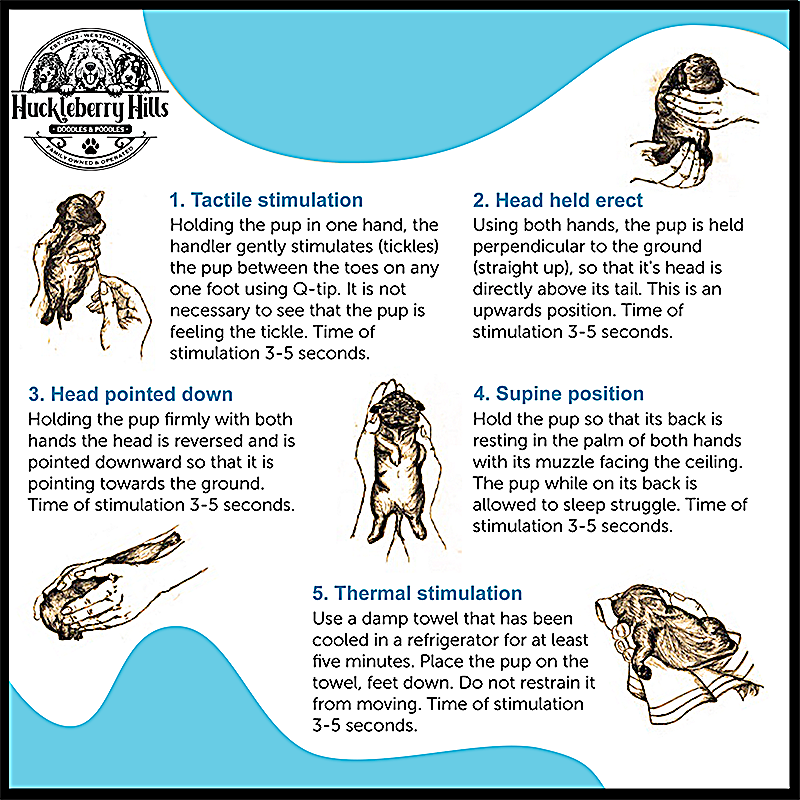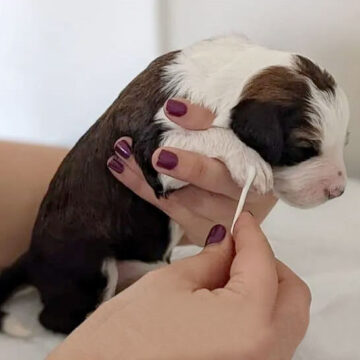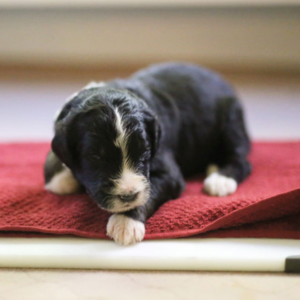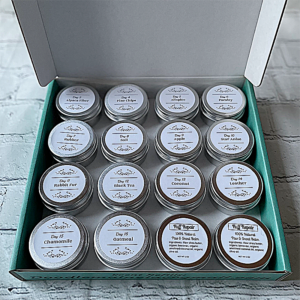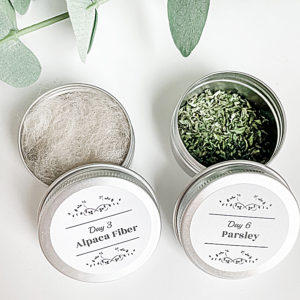ENS & ESI Stimulation Exercises
Early Neurological Stimulation (ENS) and Early Scent Introduction (ESI) is the first step in our Puppy Curriculum. They are simple exercises to which puppies are exposed to from days 3-16 to help aid their development, resilience and coping mechanisms. These early puppy stimulation exercises do not take long to perform but pay off huge dividends in the long run.
Early neurological Stimulation
During days 3-16, our puppies experience Early Neurological Stimulation (ENS) using the US Military’s Bio-Sensor Program. ENS helps to stimulate the neurological system, which improves the growth and development of the puppy’s immune system, cardiovascular system and stress tolerance. Studies show that performing ENS can also provide a greater resistance to diseases.
Benefits of ENS Stimuli
- Improved cardiovascular performance
- Stronger heart beats
- Improves circulation
- Boost brain development
- Stimulates the neurological system
- More tolerance to stress
- Improves immune system
- Greater resistance to disease
- Stronger adrenal glands
Specific ENS Stimuli
Each Bio Sensor Stimuli is preformed gently, only once a day and only for 3-5 second. because over stimulating can cause adverse and detrimental reactions. These neurological exercises are done in addition to the normal routine handling, play socialization or bonding our puppies receive daily.
- Head down
- Head up
- Supine Position (On Back)
- Thermal Stimulation
- Tactile Stimulation
Early scent introduction
In conjunction with ENS, we perform Early Scent Introduction (ESI) with all our pups during days 3 – 16 as well. ESI is designed to enhance a puppy’s ability to identify and react to specific scents. Dogs that are introduced to ESI not only have better scenting skills as adults to perform certain tasks or jobs, they have also proven to have a more optimistic attitude toward life and with that, fewer behavioral problems.
Early Scent Introduction is a concept developed by Dr Gayle Watkins, a Golden Retriever breeder, scientist, researcher and competitor in a range of dog sports. She discovered that over 7 years of implementing this into her early puppy raising protocol, their dogs introduced to ESI had increased scenting titles. In addition, these dogs were earning titles in more complex scenting categories. Dogs achieving these titles were two and a half to five years younger than those who did not have ESI.
ESI should be performed at a different time of day to ENS. If the puppies are feeling mild stress from the ENS, you do not want them to associate that stress with the novel scents you are introducing.
Scent is the way puppies experience the world. Introducing natural scents early on can help. Research has shown that when puppies are exposed to scent at this early age, they have an association and a recognition towards that specific scent.
Benefits of ESI Stimuli
- Introduce puppies to new scents in a controlled way.
- Improves scenting ability in later life.
- Enhances confidence and stability as adults.
- Reduces behavioral issues in the long term
- Great for hunting, tracking, & diabetic alert dogs
Specific ESI Stimuli
A kit purchasable on Etsy contains these various scents: soil, pine shavings, cinnamon, star anise, lavendar, black tea, tennis ball, coconut, leather, rabbit, chamomile, alpaca, cloves, lemon grass, bonus scent, bonus scent.
You can make your own kit by collecting a selection of 13 natural scents, no chemicals or meat products. You can use herbs and spices, things from your garden, or training items to make up your collection of scents to introduce. Other options: mint, cloves, lemon, apples, grass, essential oils, cat hair, sheep wool, duck or goose feathers, chicken feathers, cloths with goat scent, leaves, leather tracking gloves, allspice, red pepper, ginger, rosemary, coconut, soil, garlic, nutmeg, peppercorn, clove, poppy seeds, oregano, orange peel, etc.
In training dogs for AKC one of their first scents used is birch so including that would be a good choice. If you will be utilizing your dog to hunt for moose and deer sheds using an antler scent would be a good choice, too.
Sound desensitization
In the second stage of our Puppy Curriculum, we introduce puppies to brief “loud noise exposure” on day 18, 19, & 20. When puppies are this young, they do not fear sound, so we use this as an opportunity to get a head start on desensitization of loud noises. This is as simple as banging a spoon on a metal bowl three times. As puppies develop their senses around three weeks, we gradually begin to expose them to a variety of sounds that they may encounter in their forever homes. Examples include: TV, vacuum, garage door, clapping hands, shouting, music, lawn mower, atvs, vehicles, sirens, blow dryer, etc. All puppies are closely monitored during this time to ensure they do not become stressed.
soundtrack work
We use a variety of soundtracks designed to prepare them for life outside our home. We find these soundtracks make a significant difference in our puppies’ confidence levels and they help with their move into their new homes, which are filled with all sorts of new sounds and experiences.
Soundtracks we use are started at a very low level and gradually increased so it doesn’t produce stress, but gently gets them used to the sounds. Some sounds included are the following:
- Busy street & traffic sounds
- Motorcycle sounds
- Thunderstorms sounds
- Wind Sounds
- Fireworks sounds
- Apartment living and baby sounds
- Heavy machinery & construction sounds
- Airplane sounds
A soundtrack we have found that helps soothe our dogs when placed in stressful situations.
Handling exercises
During the first two weeks, there is minimal handling as mom is caring for her puppies. At week 3 the next stage of our Puppy Curriculum starts and we begin our handling exercises. We rub ears, cover eyes, rub belly in circular motions, run hand down back and tail, touch paws, tap nails, run fingers around neck & under collar, and touch nose. We allow puppies to smell our face, then we hold them snug to our chest until they’ve settled. This is meant to condition puppies to human touch and it is never meant to upset or stress them. Our goal is to create a positive experience each time a puppy is held. We continue the handling exercises until puppies go home, each week slightly increasing the intensity and pressure.
socialization & Exposure Activities
For our puppy curriculum at three weeks old, we place a novelty item (gentle and safe) in the whelping box so that puppies can explore at their own leisure. We do this for an entire week, and we typically use rolled-up towels, buckets, small boxes, stuffed animals, & pillows. This item stays in their whelping box during the day and it’s typically taken out once all puppies have either lost interest or they have fallen asleep. If puppies do well with one exposure item, we may decide to add a few throughout the day. The main goal of this activity is to build trust with our puppies.
At four weeks old, we begin following an exposure activity process. We will use many items to expose our puppies throughout the coming weeks as they grow and develop. These items are listed in order from beginner to advanced. We move throughout the exposure items as they are ready, never overstimulating puppies. Each litter is assessed and moved through these items at an appropriate pace. Some litters may not accelerate as quickly as others, so we take this into consideration with each litter and adjust our puppy curriculum accordingly.
Exposure puppy curriculum
Day 28-34:
Stuffed toys
Big blocks
Bubble wrap
Rubber Toys
Day 35-41:
Water bottles
Objects with wheels
Ball Pit (plastic colored balls)
Snuffle mats (tactile work)
Day 42-56:
Water exposure
Brain games (using kibble or treats)
Balloons/Plastic Bag (overhead exposure)
Slides/Steps with landing
Crate Exposure
Exposure to new location
Car/ATV rides

